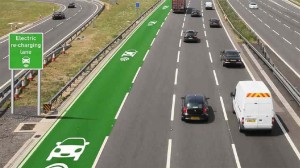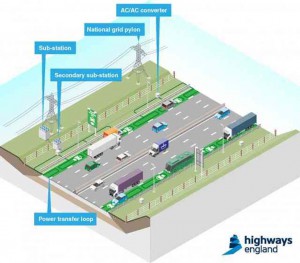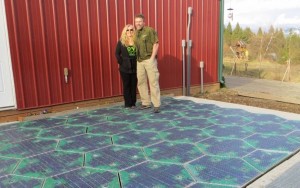Imagine being able to drive as long as you’d like, the length of your trip limited only by the capacity of your bladder, not by the size of your fuel tank – or your battery.
A pilot project about to get underway in England could make it easy. The government-owned Highways England is launching an 18-month trial that eventually may help eliminate so-called “range anxiety,” making it possible for electric vehicles to charge while they drive, drawing power from the road itself.
It’s one of a variety of creative concepts that highway planners are studying. A Dutch company wants to replace conventional asphalt with interlocking, Lego-like blocks created from recycled soft drink bottles. A U.S. entrepreneur, meanwhile, wants to replace conventional pavement with blocks of glass, turning the road itself into a giant solar panel, generating power that perhaps could be used for recharging electric vehicles.
“Vehicle technologies are advancing at an ever increasing pace and we’re committed to supporting the growth of ultra-low emissions vehicles on England’s motorways,” said Mike Wilson, chief engineer for Highways England.
The government agency is setting up a pilot project where the pavement will conceal a network of buried cables and coils. Specially equipped vehicles will be able to tap the electromagnetic fields that the system creates, recharging their batteries while driving, rather than having to pull over and plug in.
The concept is similar to the inductive charging systems commonly used for consumer electronic devices such as toothbrushes or cellphones. A number of automakers, including Tesla, BMW and Nissan are working on inductive chargers that could be set up in a private or commercial garage.
(Audi, Aston Martin developing new battery SUVs to challenge Tesla Model X. Click Here for more.)
The big difference here is that the British system wouldn’t require a vehicle to be parked. A motorist would tap into the electromagnetic field even while racing along on one of the fast British motorways.
That could provide a significant advancement over today’s battery-car technology. With the exception of the Tesla Model S, most electric vehicles can barely manage 100 miles on a charge. And Tesla buyers pay a significant premium for the larger battery packs needed to travel longer distances.
Even then, battery vehicles typically must be recharged for hours before they’re ready to roll again, something that makes a long trip a chore.
The Highways England project isn’t the first to try building chargers into the road. Another U.K. venture, in the London suburb of Milton Keynes, allows special buses to recharge every time they stop at a station along their route.
In South Korea, two electric buses operating on a 7.5-mile route in the city of Gumi can tap into a similar, buried power network, using a concept called Shaped Magnetic Field in Resonance, or SMFIR.
Officials with Highways England claim their technology is even more advanced, among other things being more effective at transferring energy from the underground coils to vehicles. And the system would be able to handle a fleet of passenger cars, not a limited number of specially equipped buses.
For now, Highways England will test the technology on special routes with a small number of participants, but officials suggested they could expand the project onto public roads if it proves successful.
In the coming years, motorists could see such systems become commonplace, proponents suggest, especially if there’s no breakthrough in battery technology that would allow electric vehicles to store more power and slash charge times.
“Vehicles capable of being charged directly from the road during operation could become the next pioneering step in the development towards reduced environmental impact,” said Niklas Gustavsson, Executive Vice President of Corporate Sustainability for the Volvo Group. Volvo is testing another in-road vehicle charging project in its home town of Gothenburg Sweden.
But researchers are looking at other ways to improve on today’s roadways. Among other things, they’re considering alternatives to conventional concrete and asphalt that might be cleaner and longer lasting.
That plastic soft drink bottle you’ve stuck into your car’s cupholder as you race down the road could see new life as part of the road itself. At least, that’s the idea of a small Dutch company called KWS Infra. Dubbed PlasticRoad, the materials could last as much as three times longer than conventional pavement and withstand temperatures ranging from -40 to 176 degrees Fahrenheit.
(For more on the PlasticRoad project, Click Here.)
The plastic blocks would have built-in conduits to route wires, drainage pipes and other roadway infrastructure. And it would simply be a matter of changing out those pieces, much like Lego blocks, to add another lane or move the road itself.
Meanwhile, a small U.S. start-up based in rural Idaho has been tinkering with a way to replace conventional roads with hexagonal blocks of glass-encased solar cells. Entrepreneurs Julie and Scott Brusaw have already paved a driveway with the material and have generated several million dollars in federal grants and crowdsourced funding to test the technology.
As with the PlasticRoad concept, those blocks could be fitted with pipes, wires and perhaps even a charging grid for electric vehicles that would tap energy generated by the road itself.
(Click Here for more on the solar road project.)




And tax payers in the UK are just as unhappy as those in the U.S. who feel that private enterprise should fund any infrastructure for EVs as they do for petrol, Diesel, CNG, or propane powered vehicles.
All EV operators should be charged a special tax to cover building these types of test road systems and these people should pay an annual fee for use of roads with electric recharging just as they should for public parking area recharging systems. Other motorists should not be subsidizing the impractical EVs being perpetuated by those who have a financial interest in these products.
At one time the united states had one the best mass transit systems in the world. You could ride coast to coast. Then a group of companies including gm and mack truck and oil companies bought them and ripped up the tracks and burned the rolling stock publically. The companies were found guilty. Private enterprise trying to monopolize transportation. Electric powered transportation in coming again only this time we know the proproganda whinning about voodoo facts about economics that make no since. Until its only the flat landers chanting about the shy falling.
At one time the united states had one the best mass transit systems in the world. You could ride coast to coast. Then a group of companies including gm and mack truck and oil companies bought them and ripped up the tracks and burned the rolling stock publically. The companies were found guilty. Private enterprise trying to monopolize transportation. Electric powered transportation in coming again only this time we know the proproganda whinning about voodoo facts about economics that make no since. Until its only the flat landers chanting about the sky falling.
Wrong again… The U.S. NEVER had a good mass transit system. We had a coast-to-coast mainline and many spurs but that is NOT mass transportation as known by most people and countries where anyone in any town can use public transportation to travel pretty much anywhere. Because the U.S. is so massive in scale it never will have a good nation wide mass transit system because of the sparsely populated areas and the public’s desire to be able to come and go as they please via an auto. That is why autos have been selling so well worldwide for close to a hundred years. Most people prefer the freedom of choice and they pick autos over mass transit for the most part.
The only voodoo is the foolish nonsense that you continue to post whenever someone discloses the ignorance and inappropriate actions associated with impractical EVs. Tax payers should not be paying for someone else’s pipe dreams. Those who think owning an EV will save the world should pay their fair share to operate an EV including road taxes and all cost for charging infrastructures. No one pays my road taxes or provides a tax break because my car gets excellent fuel economy and meets very stringent exhaust emissions so there is no reason to be subsidizing impractical EVs with consumer or tax payer’s money. If you want an EV then pay your way like everyone else does.
I would suggest that you lose the dribble about flat landers, voodoo economics, etc. because it illustrates your inability to deal with reality. You continue to attack people because you have no defense for the stated injustices of subsidizing EVs. If you can’t deal with the issues, as you demonstrate over and over at this news site, you’d be better off to go some place where you can dupe the gullible because no one here is buying your dribble and personal attacks. Being in denial is a choice that you have made because you can’t deal with reality.